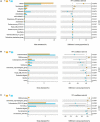Differential regulation and preventive mechanisms of green tea powder with different quality attributes on high-fat diet-induced obesity in mice
- PMID: 36245513
- PMCID: PMC9559937
- DOI: 10.3389/fnut.2022.992815
Differential regulation and preventive mechanisms of green tea powder with different quality attributes on high-fat diet-induced obesity in mice
Abstract
Tea powder has been reported to have some physiological functions. However, there is no report on whether there are differences in the active ingredients of tea powder with different qualities and whether there are different prebiotic mechanisms. This study was aimed to investigate the effects of different qualities of tea powder on preventing obesity from different aspects, namely antioxidation, inflammation, lipid-lowering, and intestinal flora, using an obesity mouse model. The results showed that all three types of tea powder with different qualities could reduce body weight and decrease serum TC, TG, and LDL-C. However, tea powder with different quality attributes exhibited diverse modulatory effects and mechanisms. Tender tea powder contained more tea polyphenols, and it had a better effect on improving oxidative stress. Tender tea powder significantly decreased the abundances of Blautia, Bilophila, and Oscillibacter, and increased the abundances of Alloprevotella, Lachnoclostridium, Romboutsia, and Ruminococcaceae_UCG-004. Coarse tea powder contained more dietary fiber, and had a better effect on reducing the food intake and improving lipid metabolism, which could reduce lipid synthesis and increase lipid β-oxidation. Coarse tea powder significantly decreased the abundance of Dubosiella and increased the abundances of the Lachnospiraceae_NK4A136 group and Coriobacteriaceae_UCG-002. Our findings provide a theoretical reference for the comprehensive utilization of tea powder.
Keywords: different qualities of green tea powder; gut microbiota; mechanisms; modulatory effects; prevent obesity.
Copyright © 2022 Wang, Dong, Hu, Wang, Li, Peng, Zhang, Liu and Wang.
Conflict of interest statement
The authors declare that the research was conducted in the absence of any commercial or financial relationships that could be construed as a potential conflict of interest.
Figures







Similar articles
-
Green tea leaf powder prevents dyslipidemia in high-fat diet-fed mice by modulating gut microbiota.Food Nutr Res. 2020 Nov 13;64. doi: 10.29219/fnr.v64.3672. eCollection 2020. Food Nutr Res. 2020. PMID: 33281537 Free PMC article.
-
Fubrick tea attenuates high-fat diet induced fat deposition and metabolic disorder by regulating gut microbiota and caffeine metabolism.Food Funct. 2020 Aug 1;11(8):6971-6986. doi: 10.1039/d0fo01282c. Epub 2020 Jul 22. Food Funct. 2020. PMID: 32697259
-
Polyphenols from Fu Brick Tea Reduce Obesity via Modulation of Gut Microbiota and Gut Microbiota-Related Intestinal Oxidative Stress and Barrier Function.J Agric Food Chem. 2021 Dec 8;69(48):14530-14543. doi: 10.1021/acs.jafc.1c04553. Epub 2021 Nov 9. J Agric Food Chem. 2021. PMID: 34752089
-
Research progress on the lipid-lowering and weight loss effects of tea and the mechanism of its functional components.J Nutr Biochem. 2023 Feb;112:109210. doi: 10.1016/j.jnutbio.2022.109210. Epub 2022 Nov 15. J Nutr Biochem. 2023. PMID: 36395969 Review.
-
Novel insights of dietary polyphenols and obesity.J Nutr Biochem. 2014 Jan;25(1):1-18. doi: 10.1016/j.jnutbio.2013.09.001. J Nutr Biochem. 2014. PMID: 24314860 Free PMC article. Review.
Cited by
-
The composition and predictive function of the fecal microbiota in female donkeys across different reproductive cycles.Front Microbiol. 2025 Jun 25;16:1565360. doi: 10.3389/fmicb.2025.1565360. eCollection 2025. Front Microbiol. 2025. PMID: 40636483 Free PMC article.
-
Influence of Matcha and Tea Catechins on the Progression of Metabolic Dysfunction-Associated Steatotic Liver Disease (MASLD)-A Review of Patient Trials and Animal Studies.Nutrients. 2025 Jul 31;17(15):2532. doi: 10.3390/nu17152532. Nutrients. 2025. PMID: 40806117 Free PMC article. Review.
-
Linear association of the dietary index for gut microbiota with insulin resistance and type 2 diabetes mellitus in U.S. adults: the mediating role of body mass index and inflammatory markers.Front Nutr. 2025 Mar 21;12:1557280. doi: 10.3389/fnut.2025.1557280. eCollection 2025. Front Nutr. 2025. PMID: 40191795 Free PMC article.
-
Multi-omics analysis on the mechanism of the effect of Isatis leaf on the growth performance of fattening sheep.Front Vet Sci. 2024 Feb 7;11:1332457. doi: 10.3389/fvets.2024.1332457. eCollection 2024. Front Vet Sci. 2024. PMID: 38384949 Free PMC article.
References
-
- Hu J, Chen Y, Ni D. Effect of superfine grinding on quality and antioxidant property of fine green tea powders. LWT Food Sci Technol. (2012) 45:8–12.
-
- Wang Dongfeng W, Wang Chenghong W, Li Jun L, Zhao Guiwen Z. Components and activity of polysaccharides from coarse tea. J Agric Food Chem. (2001) 49:507–10. - PubMed
LinkOut - more resources
Full Text Sources
Miscellaneous

